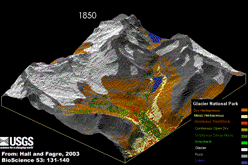AUTHORS
Daniel R. Taub1, 2 and Gillian S. Graham1
1 - Biology Department, Southwestern University, 1001 East University Ave, Georgetown, TX 78626, USA.
2 - Corresponding author: Daniel R. Taub (taubd@southwestern.edu)
THE ECOLOGICAL QUESTION
How might global temperatures change during the 21st century? How might these changes vary geographically, seasonally, and depending upon future human activities?
ECOLOGICAL CONTENT
Abiotic environment, global change, global warming, climate change, greenhouse gases, latitudinal gradients, seasonality
WHAT STUDENTS DO
Students consider how to detect trends in large data sets against a background of variation. They use output from global climate models to examine projected climate change during the 21st century under a range of greenhouse gas emissions scenarios. Using Excel, they graph projected changes in temperature at particular locations over time and perform linear regressions. They compare projections of temperature change among emissions scenarios, across latitudinal gradients and between seasons. These exercises are adaptable to studying a wide range of climate parameters at any terrestrial location.
SKILLS
Working in groups, working with spreadsheets, detecting and comparing trends in data and making inferences, presenting data using figures, comparison of data collected in different locations and under different conditions, report writing.
STUDENT-ACTIVE APPROACHES
Guided group discussions take place throughout. Some discussions take place first within small groups and then are expanded to the larger class (Think-pair-share). Students consider questions, design and conduct analyses and make comparisons. Student groups combine data analyses using a jigsaw approach.
ASSESSABLE OUTCOMES
Students produce graphs and statistical analyses and orally present and discuss their findings. If instructor desires, they may also produce a written report.
SOURCES
Canadian Centre for Climate Modelling and Analysis. Online data repository, http://www.cccma.ec.gc.ca/data/data.shtml
DOWNLOADS
- Full Article Text [doc], [pdf]
- Student dataset (This file contains data for 19 latitudes.) [xlsx]
- Faculty dataset (This file contains data contains data for 19 latitudes, and the faculty file additionally contains the regression slopes and R-squared values for regressions of temperature on year for both January and July for each of the latitudes under the three emissions scenarios in Table 1, and under an additional set of conditions that represent a control set of conditions (the Committed scenario) under which concentrations of greenhouse gases remain constant at year 2000 concentrations.) [xlsx]
- Student assignment [doc]
- Appendix 1: Downloading additional model output [doc]
- Appendix 2: Kelvin to Celsius Conversion [doc]
Data sets
Additional Resources
